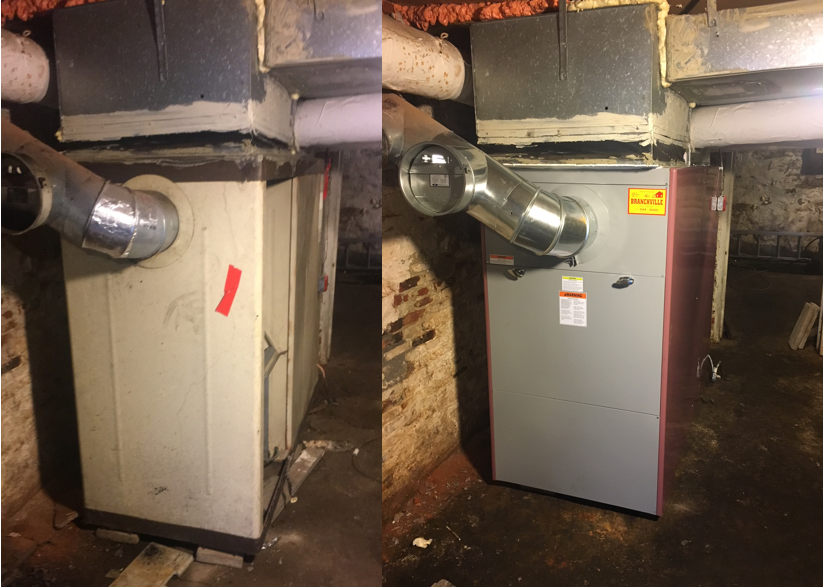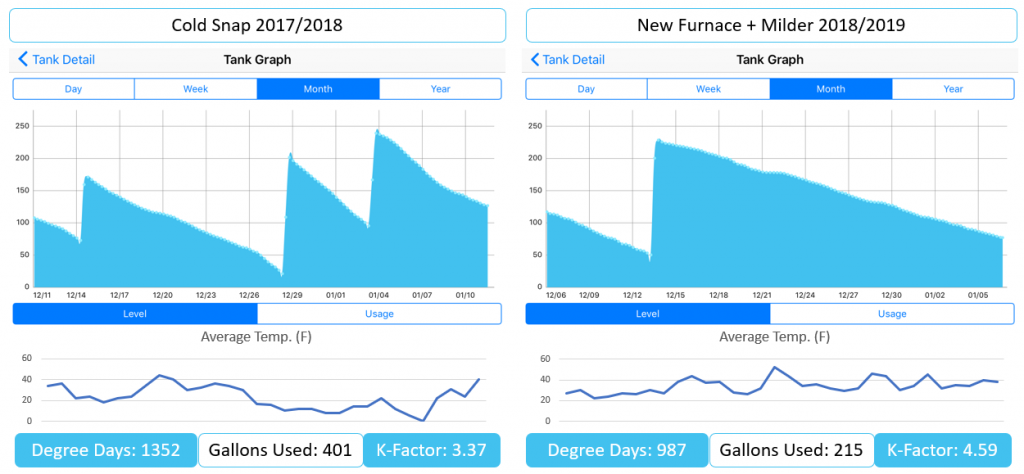If you live in an older home, you probably dread the heating bills that come every winter. Since older homes tend to have older windows and less insulation than newer homes, then tend to require more heating oil to maintain a comfortable temperature inside. As someone with firsthand experience living in an older home, I will share some tricks and tips on how to conserve heating oil in an old home and track your oil usage while doing so.
Three Areas to Focus on to Conserve Heating Oil
My house in Connecticut was built in 1865 and is virtually all original. While this can be extremely charming, it comes with its downsides! For instance, the windows are from 1865. As you can imagine, they are not sealed very well. When I first moved in, the wind would literally blow papers off the kitchen table. As cold air would blow in, the warm air would blow out, and my heating oil bills were outrageous.
Over the years I worked out several ways on how to conserve heating oil, and I spend significantly less now on heating oil. The three areas to focus on for conserving heating oil are:
- Heat loss – identifying where heat is escaping
- Heat generation – keeping your burner in good condition
- Heat setting – adjusting your thermostat and monitoring your oil consumption

Heat Loss: Identifying Where Heat is Escaping
If it sounds like your furnace or boiler is working overtime, you probably have a lot of heat escaping your house. As warm air escapes, cool air comes in and replaces it, lowering the temperature inside. The main sources for heat loss in a home are:
- Windows
- Walls
- Doors
- Duct work
Windows
Single pane windows create much of the charm of older houses. However, they do very little to keep the heat in. Modern windows have two panes, with an air pocket in between. This air pocket acts as insulation to keep the heat in your home. If your home has single pane windows, you should consider applying plastic film to seal them. This film is easy to come by, and not too difficult to install. Just cut the film to size and use double-sided tape to adhere it. Once secure, use a hairdryer to shrink it in place. If done properly, you will not even notice it! But it will undoubtedly feel more comfortable in the house once done.

Walls
Walls are also a major source of heat loss. As such, if you are embarking on any major renovations to your house, you should consider adding insulation to help you conserve oil. Blown in insulation tends to be quite cost-effective and can often be subsidized through an energy audit that your state offers. Once the insulation has been added, you should see a decline in heating oil usage immediately.
Doors
Since doors are constantly being opened and closed throughout the day, it is unlikely that they are perfectly sealed when shut. As a result, you likely have drafts at your exterior doors, especially at the bottom. On a cold day, place your hand near the base of your doors to feel for cold air. If it feels cold, you should consider a ‘door sweep’ or ‘draft blocker’. There are various types of these, with varying degrees of installation difficulty and effectiveness. The simplest ones can be slid right under the door without any screws and will do a good job of keeping the cold out.
Duct Work
This one came as a major surprise to me when I had my energy audit done. My house has what’s known as ‘forced hot air’ as its heating type. With this setup, I have a furnace in the basement that heats air in a heat exchanger. Once the air is hot, the furnace blows this hot air through ducts into the rooms of the house. At the same time, it sucks in air through ‘return’ vents in the house. Since these return ducts are bringing in the room-temperature air from the house, the furnace does not have to heat cold air from the outside.
With my house, however, I have a VERY cold, unheated basement. As a result, the air in the basement is constantly cooling the ducts. This makes the furnace work extra hard, as it is inadvertently heating the basement. Wrapping these ducts in insulation helps keep this heat headed to its final destination and keeps the return air from being unnecessarily cooled as it returns to the furnace. Also, the insulation helps seal any leaks on the ducts, keeping the hot air inside.
Heat Generation: Keeping Your Burner in Good Condition
Your boiler or furnace is the ‘engine’ that creates the heat in your home. Just like it’s important to change the oil in your car on a regular basis, servicing your burner should be a regular event. A furnace tune-up should be done at least every other year. Best case, you should have your furnace tuned up annually. An annual cleaning and tune-up will help allow the technicians to spot any potential issues before they occur. Staying ahead of problems with your system will ensure the heat stays on all winter and save you money in the longrun.
A furnace tune-up should be done at least every other year.
There are also catastrophic issues that the technicians can spot, such as a crack in the heat exchanger. This can lead to harmful exhaust gases entering the home. When this happens, it is definitely time to replace your furnace.
An oil-fired furnace or boiler is usually built to last 20-30 years. If your system is much more than 20 years old, you should consider replacing it. Newer systems are much more efficient, quieter, and can generally output more heat. My system was 28 years old when I replaced it in 2018. Prior to replacing it, I had gathered lots of data on my oil consumption through my Smart Oil Gauge. This allowed me to see exactly how much oil the new system was saving me each winter.

Heat Setting: Adjusting the Thermostat and Monitoring Oil Consumption
The best thing I did since moving into this house was install a Smart Oil Gauge to track my heating oil usage and consumption. Since the Smart Oil Gauge shows me my hourly burn rate throughout the day, I was able to determine what to do with my programmable thermostat. Since I have forced hot air, I lower the temperature while I’m not home during the day. Reheating the house does not take very long, and only causes a short spike in oil consumption.
For homes with boilers and radiators, it takes much longer to reheat the home. What our data from Smart Oil Gauges shows is that it is best to leave the temperature the same all day, or only lower it slightly in homes with boilers.
The best part about having the Smart Oil Gauge though, was analyzing the savings from my new furnace. By exporting the data from a one-month period with the old furnace, and overlaying average temperature in my town, I was able to calculate the K-factor for my old system. The K-factor determines how long your heating oil lasts you. The higher the K-factor, the longer a gallon of heating oil lasts. To understand the math below, there is one more variable to be aware of: degree days. The degree days figure is used to determine how much heat is required to warm a house on a given day. Using 65° F as a baseline, degree days can be calculated by subtracting the average temperature on a given day from 65.
For example, if the average temperature is 30 one day, then that day is considered to have had 35 degree days (65 – 30 = 35). In Connecticut, we see approximately 5,930 degree days over the course of a year.
Calculating the Savings From My New Furnace
With the exported data from my Smart Oil Gauge, I determined that my K-Factor from the old furnace was approximately 3.37. With 5,930 degree days per year, that put my annual usage at around 1,760 gallons in a typical winter. This is about right, looking at my Smart Oil Gauge consumption.
With my new furnace, the K-Factor was increased to 4.59. This means that in the same winter, my house will now use only 1290 gallons. This is a savings of 470 gallons of heating oil per year – which adds up fast!!
My New Furnace Saves Me 470 Gallons of Heating Oil Per Year

Summary: Conserving Heating Oil in an Older Home
The first question you should ask yourself is where you can get the biggest savings without spending much money. Obviously, a new furnace would be nice to have, but this can cost thousands of dollars and may not be necessary right away. As such, start with containing the heat by eliminating drafts. Seal your windows with thin plastic film. Then, go around and install door sweeps under the exterior doors. If you have any French doors, or sliding glass doors that you do not use in the winter, consider wrapping those in plastic as well.
Finally, get a handle on your oil usage by installing a Smart Oil Gauge. This will show you exactly when you’re using your heating oil. You can optimize the settings on your programmable thermostat and begin saving oil immediately. When you’re ready to add insulation to your house, or install a new furnace or boiler, look for any local subsidies that may be available in your state.
Once you’ve taken care of the areas where your heat is escaping, be sure to visit FuelSnap’s heating oil price comparison tool. FuelSnap finds local home heating oil dealers and allows you to compare prices (saving you money!). New England oil prices fluctuate but with FuelSnap you’ll always find the best rate.
Happy heating,
Steve



